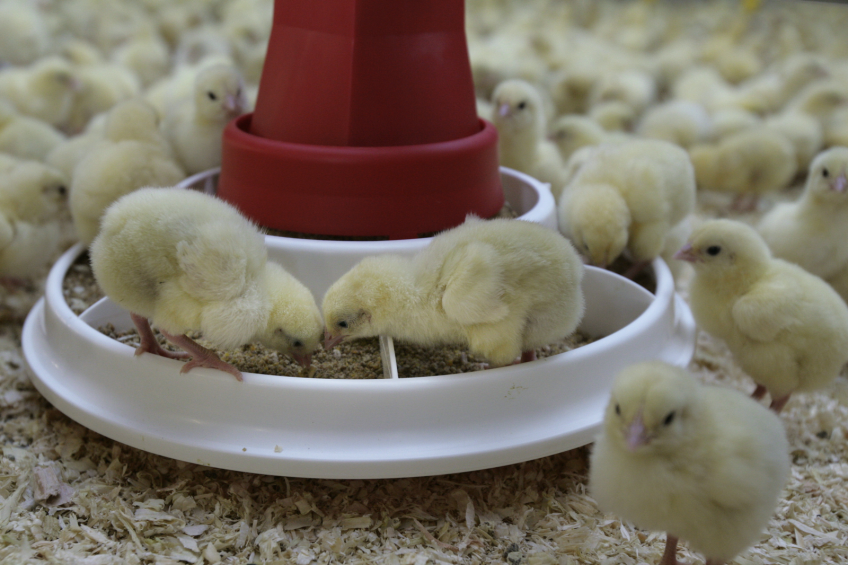Narasin to protect intestinal integrity

Coccidiosis is likely the most costly disease threat to global poultry production. Prevention is essential in order to maintain intestinal integrity and the efficient absorption of nutrients in the chicken. The use of narasin is an effective means to achieving this condition.
By Dr Thomas K. Jeffers, Department of Animal Science, Cornell University, Ithaca, NY, USA
Narasin is an ionophore anticoccidial. Ionophores transport cations such as sodium across the pellicle membrane of sporozoites of coccidia, resulting in a lethal osmotic imbalance and the death of the coccidia.
Narasin has unique properties that set it apart from other ionophore anticoccidials, thus making it an ideal anticoccidial in protecting the intestinal integrity of broiler chickens and assuring optimal growth performance.
Continuous prophylactic control of coccidiosis is required in order to maintain intestinal integrity and profitability in poultry production.
Sporozoites of coccidia accumulate ionophores, such as narasin in their pellicle membrane, resulting in an influx of sodium into the sporozoites, thus exceeding the parasite’s ability to remove the excess sodium. In turn, this leads to the death of the coccidia through energy depletion and a resultant lethal osmotic imbalance.
Anticoccidial efficacy
The effectiveness of narasin against all pathogenic species of coccidia of chickens in both battery cage and floor pen trials was demonstrated, based upon mortality, weight gain, feed conversion and lesion scores. In these trials, birds medicated with narasin consistently performed as well as, or better than, those medicated with the ionophore monensin. Also production figures under commercial broiler production conditions for birds medicated with narasin or monensin, were compared.
The results of which are shown in Table 1. These results showed that average live weights at slaughter were significantly higher for broilers medicated with narasin at 60 or 80 ppm than for those medicated with 100 ppm monensin. There were no other differences when mortality, lesion scores and feed conversion rates were compared.
Synergism of narasin and nicarbazin
When combining different ionophores with the anticoccidial nicarbazin (an equal molar complex of 4,4′-dinitrocarbanalide and 2-hydroxy-4,6-dimethylpyrimidine), Callender and Jeffers unexpectedly found that combinations of nicarbazin and narasin had synergistic activity. Subsequently, a synergistic 1:1 mixture of narasin and nicarbazin was developed as the anticoccidial Maxiban, which has become widely adopted as an anticoccidial by broiler producers worldwide.
In addition to anticoccidial activity, there are a number of other benefits of narasin.
Additional benefits
In addition to anticoccidial activity, there are a number of other benefits of narasin reported in scientific journal publications.
Necrotic enteritis is caused by the bacterium Clostridium perfringens type A, and is a significant disease of broiler chickens worldwide. Control of this condition is dependent on a variety of elements, including reduction of predisposing intestinal infections such as coccidiosis, and the use of feed additive antibiotics. However, in some countries the use of such antibiotics in feed is prohibited, thus eliminating this practice as a means of preventing necrotic enteritis.
Among the ionophores approved for use in broilers, narasin is very effective in preventing coccidiosis as a precursor to necrotic enteritis, as shown in studies in broilers simultaneously challenged with coccidia and C. perfringens. These results were confirmed, with respect to the activity of narasin in broiler chickens challenged with mixed species of coccidia and C. perfringens as shown in Table 2. This property of narasin is especially valuable to broiler producers in global areas where the use of conventional antibiotics in feed is banned.
No side effects
Lastly, narasin produces no deleterious side effects when included in the ration of broilers either on its own, or in combination with nicarbazin. Likewise, the rapid elimination of narasin alone or the synergistic combination Maxiban from the tissues of medicated broilers, has resulted in no regulatory requirement for withdrawal of either product from the ration prior to slaughter in several major broiler producing areas.
This has been a great help to poultry producers in protecting the intestinal integrity of their birds right up to slaughter, as well as in managing the practice of ‘thinning’; the logistics of feed storage and delivery; and the scheduling of flocks going to the slaughter plant.
Proven advantages
Aside from outstanding anticoccidial efficacy when used alone, or in combination with nicarbazin, narasin has several other proven advantages that make it an ideal anticoccidial in protecting intestinal integrity and in turn, assuring optimal broiler growth performance and profitability in broiler production. These advantages include superior growth performance, activity against concomitant infection with coccidia and C. perfringens and freedom from deleterious side effects.
References are available from the author – jeff6382@aol.com
[Source: World Poultry – Managing Coccidiosis, 2014]












